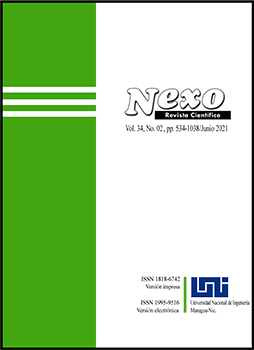Caracterización de la macrofauna edáfica en diferentes sistemas agroforestales, en el Municipio de San Ramón, Departamento de Matagalpa, Nicaragua
DOI:
https://doi.org/10.5377/nexo.v34i02.11542Palabras clave:
Agroforestal, Monolito, EstratoResumen
El presente estudio de focalizo en caracterizar la macrofauna edáfica en tres diferentes sistemas agroforestales: CMIEA: Café, musáceas, Inga, Erithryna y árboles, CIE: Café, Inga, Erithryna y árboles y CA: Café y árboles en época seca y época lluviosa. Cada sistema tenía 900m2, presentaban aproximadamente 6 especies arbóreas por sistema. Se tomaron 32 monolitos por época, y este se dividió en cuatros estratos (hojarasca, 0 a 10cm, 10 a 20cm y 20 a 30cm) con el método recomendado por el Tropical Soil Biology and Fertility Programme. La macrofauna se conservó en alcohol al 70%, exceptuando las lombrices que fueron preservadas con formalina al 4% y se trasladaron al Laboratorio de Entomología del Departamento de Agroecología de la UNAN-León para su respectiva edificación. Los resultados demuestran que los valores mayores de la abundancia se presentaron en la época lluviosa (391 individuos) y en la época seca (324 individuos). La mayor abundancia se encontró en el sistema CMIEA (162 individuos) en la época lluviosa y mínima en el sistema CA (91 individuos) en la época seca. El índice de diversidad de Shannon fue más alto en el sistema CA (2.73) en la época seca y mínimo en el sistema CIE (1.44). Los arreglos de los sistemas agroforestales no influyen en la abundancia de la macrofauna, sin embargo, favorece la presencia de especie de Philoscidae y lombrices de suelos orden Haplotaxida.
Descargas
1091
Descargas
Publicado
Cómo citar
Número
Sección
Licencia
Derechos de autor 2021 Universidad Nacional de Ingeniería

Esta obra está bajo una licencia internacional Creative Commons Atribución 4.0.
Los autores que publican en Nexo Revista Científica están de acuerdo con los siguientes términos:
- Los autores conservan los derechos de autor y conceden a la revista el derecho de la primera publicación bajo la licencia Creative Commons Attribution License, que permite a otros compartir el trabajo con un reconocimiento a la autoría de la obra y a la publicación inicial en Nexo Revista Científica.
- Los autores pueden establecer por separado acuerdos adicionales para la distribución no exclusiva de la versión de la obra publicada en la revista (por ejemplo, en un repositorio institucional o en un libro) con el reconocimiento de su publicación inicial en Nexo Revista Científica.
- Se permite y se anima a los autores a difundir sus trabajos electrónicamente (por ejemplo, en repositorios institucionales o en su propio sitio web) antes y durante el proceso de envío, ya que puede dar lugar a intercambios productivos, así como a una citación más temprana y mayor de los trabajos publicados.










